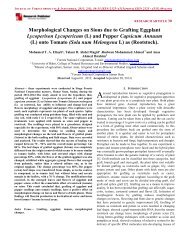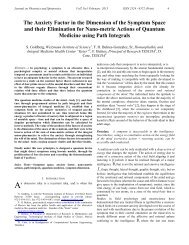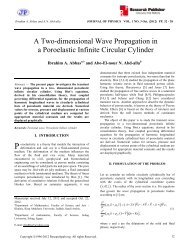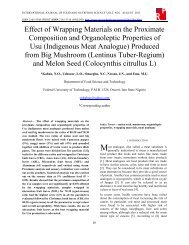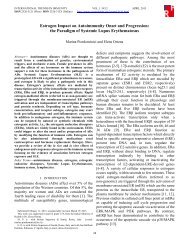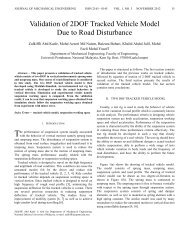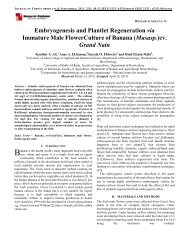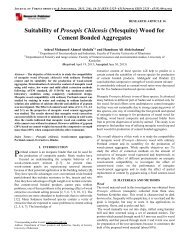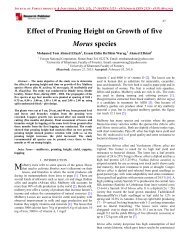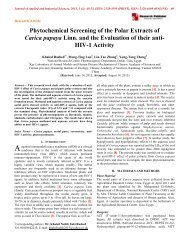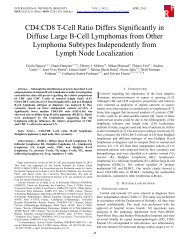Antiviral Activity and Phytochemical Analysis of Ailanthus Excelsa ...
Antiviral Activity and Phytochemical Analysis of Ailanthus Excelsa ...
Antiviral Activity and Phytochemical Analysis of Ailanthus Excelsa ...
You also want an ePaper? Increase the reach of your titles
YUMPU automatically turns print PDFs into web optimized ePapers that Google loves.
JOURNAL OF FOREST PRODUCTS & INDUSTRIES, 2013, 2(3), 30-33 ISSN:2325–4513(PRINT) ISSN 2325 - 453X (ONLINE)31resulted in the isolation <strong>of</strong> major compound <strong>of</strong> the chlor<strong>of</strong>ormextract, canthin-6-one, detection <strong>of</strong> this compound wasdetected by sparing with dragendr<strong>of</strong>f reagent which is specificfor alkaloids on TLC in which the compound gave red-orangespot.Preparation <strong>of</strong> the extracts for bioassayExtracts were dissolved as 100 mg in 1 ml <strong>of</strong> 10% DMSO inwater. The final concentration was 100 µg/ µl (Stock solution).The dissolved solutions were sterilized by addition <strong>of</strong>antibiotic antimycotic mixture [19] Sterility test were carriedout in nutrient agar.Cell CultureAfrican green monkey kidney-derived cells (VERO) wereused. The cells were propagated in Hanks ٫ Minimum essentialmedium, MEM supplemented with 10% Foetal bovine serum,1% antibiotic-antimycotic mixture. The pH was adjusted at7.2-7.4 by 7.5% sodium bicarbonate solution. The mixture wassterilized by filtration through 0.2 µm pore size nitrocellulosemembrane.VirusesHerpes Simplex virus type 1 was obtained from EnvironmentalVirology Lab., Department <strong>of</strong> Water Pollution Research,National Research Centre. <strong>Antiviral</strong> assay was carried byPlaque reduction assay [20].Plaque reduction assayA 6-well plate was cultivated with Vero cell culture (10 5 cell/ml) <strong>and</strong> incubated for 2 days at 37 C. HSV-1 was diluted togive 10 4 PFU/ml final concentration <strong>and</strong> mixed with the plantextract at 100 mg in 1 ml <strong>of</strong> 10% DMSO in water <strong>and</strong>incubated overnight at 4C. Growth medium was removedfrom the multiwell plate virus-compound mixture wasinoculated (100 µg/well). After 1 hr contact time, the inoculumwas aspirated <strong>and</strong> 3 ml <strong>of</strong> Minimal Essential Medium (MEM)with 1% agarose was overlaid the cell sheets. The plates wereleft to solidify <strong>and</strong> incubated at 37C until the development <strong>of</strong>virus plaques. Cell sheets were fixed in 10% formalinesolution for 2 hrs, <strong>and</strong> stained with crystal violet stain. Controlvirus <strong>and</strong> cells were treated identically without chemicalcompound. Virus plaques were counted <strong>and</strong> the percentages <strong>of</strong>reduction were calculated [20].III. RESULTS AND DISCUSSIONRESULTSThe Results <strong>of</strong> antiviral activity <strong>of</strong> <strong>Ailanthus</strong> excelsa stem barkextracts are included in table 1, it has shown that chlor<strong>of</strong>ormextract is more potent than methanol extract as anti-HSV-1agent, where chlor<strong>of</strong>orm extract showed virus reduction by82.6, while methanol extract showed virus reduction by 52 atthe concentration <strong>of</strong> 50 µg. <strong>Phytochemical</strong> analysis <strong>of</strong> theextracts are included in table 2 which prove that each extracthas interesting bio-active compounds, quassinoids, <strong>and</strong>alkaloids <strong>and</strong> the major alkaloid compound, canthin-6-one wasisolated from the bioactive chlor<strong>of</strong>orm extract <strong>and</strong> thechemical structure <strong>of</strong> the compound was identified by 1 H-NMR, 13 C-NMR <strong>and</strong> MSStructure elucidation <strong>of</strong> the alkaloid compound, canthin-6-one:Canthin-6-one: 1 H NMR (400 MHz, CDCl 3 ): H 6.98 (d, J =9.9 Hz, H-5), 7.50 (t, J = 7.6 Hz, H-10), 7.68 (t, J = 7.6 Hz, H-9), 7.95 (d, J = 4.8 Hz, H-1), 8.01 (d, J = 9.9 Hz, H-4), 8.09(d, J = 7.6 Hz, H-11), 8.64 (d, J = 8.1 Hz, H-8), 8.79 (d, J =4.8 Hz, H-2). 13 C NMR (100 MHz, CDCl 3 ): c 116.49 (C-1),117.30 (C-8), 122.74 (C-11), 124.37 (C-11a), 125.72 (C-10),128.95 (C-5), 130.47 (C-11b), 130.95 (C-9), 132.07 (C-11c),136.09 (C-3a), 139.49 (C-4), 139.49 (C-7a), 145.76 (C-2) <strong>and</strong>159.59 (C-6).EI-MS: m/z 220.10911811a7aON11b11c5Figure 1. Canthin-6-oneDISCUSSIONThe present study for the first time, proved antiviral activity <strong>of</strong> A.67excelsa bark extracts. The results has shown that chlor<strong>of</strong>orm hasa good antiviral activity than methanol extract (Table 1) in adose dependent mannar. Chlor<strong>of</strong>orm extract <strong>of</strong> A. excelsa stembark at concentration 20 µg has shown an inhibition for the virusby 66.5%, <strong>and</strong> at concentration <strong>of</strong> 50 µg, chlor<strong>of</strong>orm fraction <strong>of</strong>A. excelsa stem bark has a significant anti-viral activity byinhibition for the virus by 82.6%. Methanol extract atconcentration 20 µg has shown an inhibition for the virus by44.9%, <strong>and</strong> at concentration <strong>of</strong> 50 µg, it has shown inhibition <strong>of</strong>the virus by 52%. The anti-HSV-1 properties <strong>of</strong> A. excelsaextracts in this research could be due to multiple differentcomponents in these extracts. The phytochemicalcharacterization <strong>of</strong> extracts <strong>and</strong> the identification <strong>of</strong> thebioactive compounds are now needed. <strong>Phytochemical</strong> analysis<strong>of</strong> the extracts has shown that both extracts have interestingbioactive compounds include quassinoids <strong>and</strong> alkaloids (Table2). Chlor<strong>of</strong>orm extract contained canthin-6-one as the majorcomponent <strong>and</strong> the higher activity <strong>of</strong> chlor<strong>of</strong>orm extract isprobably due to the higher concentration <strong>of</strong> these bioactivecompounds in the chlor<strong>of</strong>orm extract, while methanol is lessactive due to its low concentrations <strong>of</strong> these bioactivecompounds. <strong>Analysis</strong> <strong>of</strong> both extracts by TLC has proved manyspots for chlor<strong>of</strong>orm extract <strong>and</strong> less number <strong>of</strong> spots formethanol extract <strong>and</strong> these spots were detected under ultraviolet(UV) light. Spraying these spots with vanillin-sulphuric acidreagent followed by heating for 5 min until the appearance <strong>of</strong>purplish-blue colours specific for13a4N23



